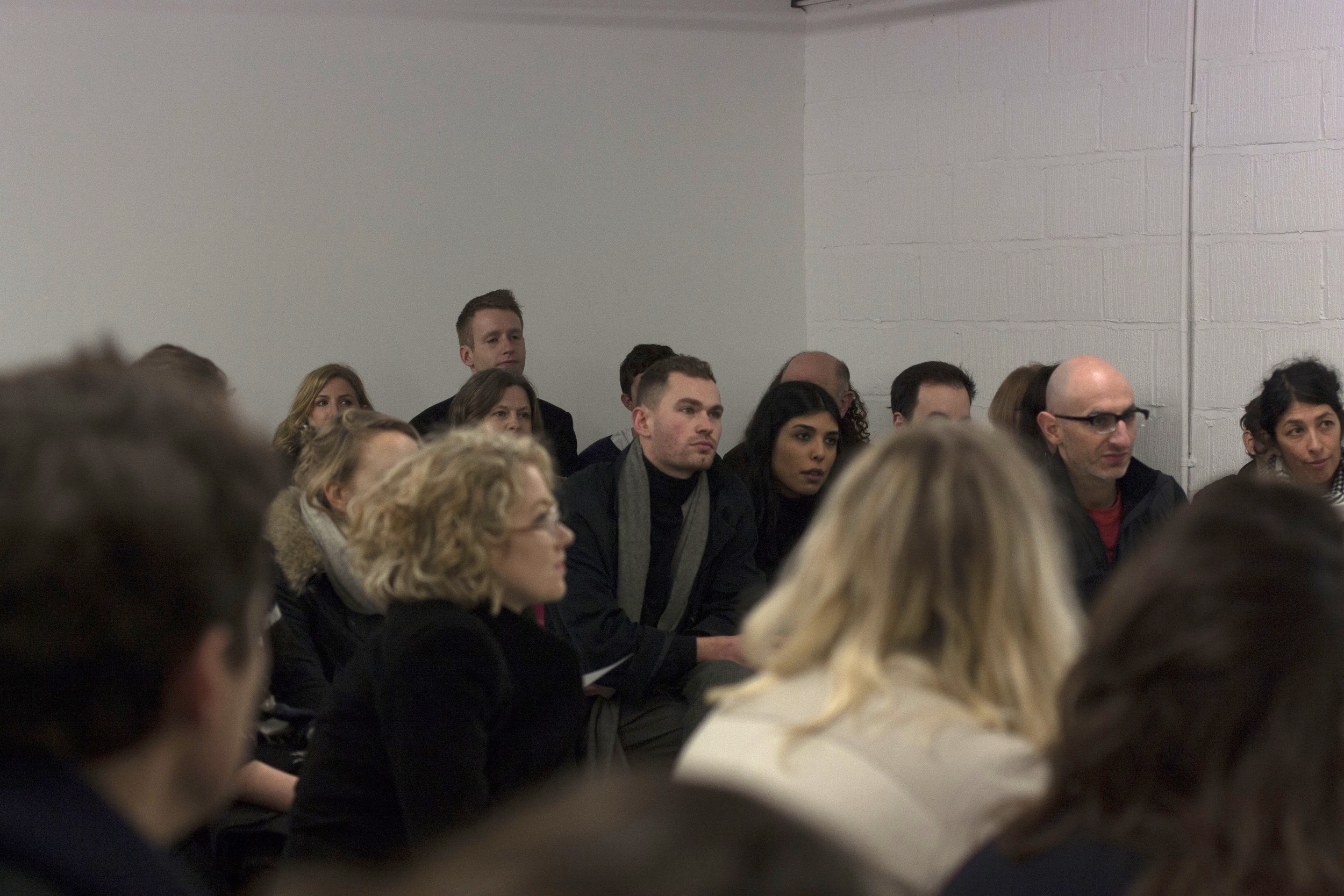A CELEBRATION IN LONDON WITH THE WHITE REVIEW: HANNAH BARRY GALLERY / 13 FEB 2015
The lashing rain did little to deter an eager crowd from gathering at Peckham Rye’s Hannah Barry Gallery to help celebrate the early successes of two young and ambitious publications that might as well have shared DNA, Music & Literature and The White Review. All around the Gallery was the work of Oliver Griffin, an artist exploring “borism,” and who had been featured, appropriately enough, in The White Review no. 3. Also on show was work by James Clapper, who combines an industrial aesthetic with performative elements, as well as Rob Sherwood, who was featured in TWR’s February 2015 online issue.
Luke Williams and Natasha Soobramanien perform a chapter from their collaborative novel.
Jacques Testard, a founding editor at TWR, kicked off the evening of readings and musical performances by introducing Natasha Soobramanien and Luke Williams. As the two publish chapters of their co-written novel across an array of literary outlets, including the chapter “Debt” in The White Review no. 12, their performance of this section highlighted the collaborative nature of the work. Reading in tandem, one author or the other occasionally fell silent, while their lines were often delivered slightly out of time; they exchanged dialogue, and at other times wholly disparate sections were read simultaneously. The effect was similar to watching a couple recite contradicting memories of the same relationship, or like a sort of dance of “competing lyrics and contrasting choruses” in which the two voices, at random moments, unified.
Daniel Medin, co-editor of Music & Literature and a contributing editor for The White Review, then explored the many ways in which M&L aims to support and promote artists who, despite exceptional catalogs and international acclaim, remain under-acknowledged in the Anglophone world. Their most recent issue is a case in point, gathering together a generous amount of untranslated work by Norwegian writer Stig Sæterbakken, Chinese author Can Xue, and Finnish composer Kaija Saariaho.
Maya Homburger and Barry Guy perform “Veni Creator Spiritus”
Two live music performances came from Swiss baroque violinist Maya Homburger, fêted for her interpretations of Bach, and double bassist Barry Guy, whose polymathic talent spans early music, jazz, and improvisation. Guy is also an accomplished composer; a graphic score of his graces the cover of M&L no. 4, which celebrates the pair’s individual and collaborative achievements. Their first set shifted seamlessly from the ninth-century hymn “Veni Creator Spiritus” into two of Guy’s own compositions, Breathing Earth and Rondo for Nine Birds. This latter piece, a response to a drawing by Fred Hellier, attempts a musical representation of a scattering of birds, with its recurrent theme providing an underlying continuity to surface chaos.
A reading by Holly Pester.
Following this rousing performance was the poet and multidisciplinary writer Holly Pester, whose research residency at the Women's Art Library, an archive of feminist art from the 1980s, inspired the first poem she read. Pester's magpie mind was in evidence throughout the reading, her poems reflecting sources that were wide-ranging and seemingly scattershot; the small sample she read contained mentions of live open-heart surgery on a prosthetic body, a lawnmower instruction manual from the 1920s, and a philosophical investigation of feet. The vocal precision of Pester's recitation—singsong cadences abruptly cut short by deadpan utterances—had the packed room laughing out loud.
Adam Thirlwell then took the stage and expressed his trepidation at his planned presentation: he would first read a selection by László Krasznahorkai, a “serious Nobel candidate,” followed by an excerpt from his own novel, Lurid & Cute. The first reading was indeed special—an excerpt from “The Sukhum Photos,” in George Szirtes’s translation, which appeared in M&L no. 2. But Thirlwell needn’t have worried. The excerpt from his latest—a scene in which Lurid & Cute’s unnamed narrator, “a seemingly sweet guy in a kind of tropical suburban paradise,” holds up a local nail salon with a replica gun—proved a splendid pairing; as Thirlwell himself noted, Krasznahorkai's writing is both “strangely comic” and intellectually formidable, and the side-by-side reading made for an intriguing congruence. He also described his first encounter with Krasznahorkai: through Animalinside, the collaborative project with the German painter Max Neumann, who himself would come to be featured alongside Krasznahorkai in Music & Literature no. 2.
Adam Thirwell prepares to read from his novel, Lurid & Cute.
The event concluded with a second set from Homburger and Guy: Mystery Sonata No. 10 “The Crucifixion” by Heinrich Biber—a series of laments punctuated by highly aggressive interludes and culminating with what Homburger called “a Baroque-style earthquake”—followed by five of Guy's Fizzles—tight, minute-long, Beckett-inspired pieces in which Guy creates specific sonorities by stroking the strings with a bristle brush or scouring a stick over the body of his bass. Though Homburger spoke of the need to avoid virtuosity for its own sake, the effect was nothing short of breathtaking; I felt truly privileged to have had the opportunity to witness two consummate artists pushing themselves—and each other—to the limits of their own creativity. In all, it was a rousing conclusion to a memorable evening. We all poured back out into the rain a touch warmer for having attended.
—Deborah Smith
All photographs courtesy of Oliver Taylor












